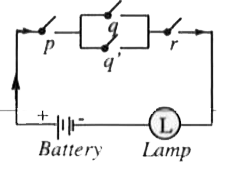When the current i is flowing through a conductor, the drift velocity is v . If 2i current is flowed through the same metal but having double the area of cross-section, then the drift velocity will be
v4
v2
v
4v
The correct Answer is:C
To solve the problem, we need to understand the relationship between current, drift velocity, area of cross-section, and the number density of charge carriers.
1. Understand the Formula for Current:
The current I flowing through a conductor can be expressed as:
I=n⋅e⋅A⋅vd
where:
- I is the current,
- n is the number density of charge carriers (electrons),
- e is the charge of an electron,
- A is the area of cross-section,
- vd is the drift velocity.
2. Initial Conditions:
When the current i is flowing through the conductor, we have:
i=n⋅e⋅A⋅v
where v is the initial drift velocity.
3. New Conditions:
Now, we are given that the current is increased to 2i and the area of cross-section is doubled (i.e., A′=2A). We need to find the new drift velocity v′d.
4. Applying the Formula for New Conditions:
The new current can be expressed as:
2i=n⋅e⋅A′⋅v′d
Substituting A′=2A:
2i=n⋅e⋅(2A)⋅v′d
This simplifies to:
2i=2n⋅e⋅A⋅v′d
5. Relating the Two Currents:
Since we know from the initial condition that:
i=n⋅e⋅A⋅v
We can substitute i in the equation:
2(n⋅e⋅A⋅v)=2n⋅e⋅A⋅v′d
Dividing both sides by 2n⋅e⋅A:
v=v′d
6. Conclusion:
Therefore, the new drift velocity v′d when the current is 2i and the area is doubled remains the same as the initial drift velocity v:
v′d=v
Final Answer:
The drift velocity will be v.
---
The current I flowing through a conductor can be expressed as:
I=n⋅e⋅A⋅vd
where:
- I is the current,
- n is the number density of charge carriers (electrons),
- e is the charge of an electron,
- A is the area of cross-section,
- vd is the drift velocity.
When the current i is flowing through the conductor, we have:
i=n⋅e⋅A⋅v
where v is the initial drift velocity.
Now, we are given that the current is increased to 2i and the area of cross-section is doubled (i.e., A′=2A). We need to find the new drift velocity v′d.
The new current can be expressed as:
2i=n⋅e⋅A′⋅v′d
Substituting A′=2A:
2i=n⋅e⋅(2A)⋅v′d
This simplifies to:
2i=2n⋅e⋅A⋅v′d
Since we know from the initial condition that:
i=n⋅e⋅A⋅v
We can substitute i in the equation:
2(n⋅e⋅A⋅v)=2n⋅e⋅A⋅v′d
Dividing both sides by 2n⋅e⋅A:
v=v′d
Therefore, the new drift velocity v′d when the current is 2i and the area is doubled remains the same as the initial drift velocity v:
v′d=v
The drift velocity will be v.
Topper's Solved these Questions
- CURRENT ELECTRICITYBook:DC PANDEY ENGLISHChapter:CURRENT ELECTRICITYExercise:Match the columns
Explore 4 Videos
- COMMUNICATION SYSTEMBook:DC PANDEY ENGLISHChapter:COMMUNICATION SYSTEMExercise:Subjective
Explore 11 Videos
- ELECTROMAGNETIC INDUCTIONBook:DC PANDEY ENGLISHChapter:ELECTROMAGNETIC INDUCTIONExercise:Medical entrances gallery
Explore 25 Videos
Similar Questions
When a current passes through a resistor, its temperature increases. Is it an adiabatic process?
View SolutionWhen current flows through a conductor, then the order of drift velocity of electrons will be
View SolutionWhen current is 4 A in a conductor the drift velocity is vd. When the current is 3 A the drift velocity will be
View SolutionWhen a steady current flows through a metal conductor of non-uniform cross-section , then drift velocity is
View SolutionWhen does the current flow through the following circuit ?

View SolutionThe water flowing through the same tube having two different cross section areas has different flow rates .
View SolutionA stready current i is flowing through a conductor of uniform cross-section. Any segment of the conductor has
View SolutionThe drift velocity of free electrons in a conductor is v, when a current i is flowing in it, Ifboth the radius and current are doubled, then the drift velocity will be :
View SolutionA steady electric current is flowing through a cylindrical conductor. Then,
View SolutionA current of 1.5A flows through a conductor for 2.0s. What amount of charge passes through the conductor ?
View Solution